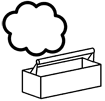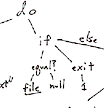 Berkeley DB is a high performance database system initially developed in the early 1990s. It’s not an SQL driven database engine – it just stores data in key/value pairs – but BDB is very fast, available to use on most operating systems, and is dual licensed for open source and commercial use. It has several benefits to just using a flat file or a PStore: transactions, fine-grained locking, replication, and hot backups, for starters.
Berkeley DB is a high performance database system initially developed in the early 1990s. It’s not an SQL driven database engine – it just stores data in key/value pairs – but BDB is very fast, available to use on most operating systems, and is dual licensed for open source and commercial use. It has several benefits to just using a flat file or a PStore: transactions, fine-grained locking, replication, and hot backups, for starters.
While Ruby bindings already exist for BDB, Matt Bauer has just released some all new shiny ones that are fast and easy to use. You’ll need to have Berkeley DB installed as a library on your system before you get started, of course. Read More



 So here we are right in the down period between Christmas and the start of the New Year. Few big releases or new developments come out at this time of the year, so it’s a good time to either enjoy time offline or.. to get reading some insightful articles we wouldn’t normally have time for! Luckily a few Rubyists have been busy spending the end of December putting together some rather good articles.. so get reading:
So here we are right in the down period between Christmas and the start of the New Year. Few big releases or new developments come out at this time of the year, so it’s a good time to either enjoy time offline or.. to get reading some insightful articles we wouldn’t normally have time for! Luckily a few Rubyists have been busy spending the end of December putting together some rather good articles.. so get reading: The Government of Fukuoka Japan, together with the Fukuoka Ruby Award Selection Committee, is running the
The Government of Fukuoka Japan, together with the Fukuoka Ruby Award Selection Committee, is running the  Apologies for the buzzword collision in the title, but
Apologies for the buzzword collision in the title, but 


 Jeremy McAnally (Twitter
Jeremy McAnally (Twitter  Whenever you run a Ruby program, Ruby’s parser processes the code and turns it into an “
Whenever you run a Ruby program, Ruby’s parser processes the code and turns it into an “

 2008 has been an interesting year for Ruby. Some people are going to remember 2008 as a snarky,
2008 has been an interesting year for Ruby. Some people are going to remember 2008 as a snarky,